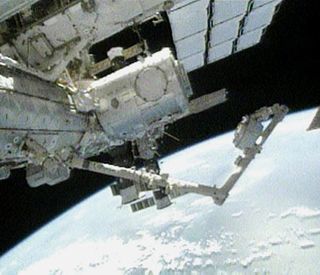Astronauts Battle Glitches to Move Space Station's Observation Deck

This story was updated at 3:05 a.m. ET.
Astronauts moved a brand-new observation deck to its final destination on the International Space Station late Sunday despite jammed bolts and other glitches that threatened their work.
Three bolts jammed at different times while astronauts tried to relocate the space observation deck to its final perch on the bottom of a brand-new room called Tranquility.
After some tweaks from Mission Control, the astronauts got past the jammed bolts only to find another malfunction. The petal-like capture mechanism securing the observation deck, known as the Cupola, to the outboard end of the new Tranquility module was stuck too.
The glitches were time-consuming but ended in a "very sweet victory," said shuttle flight director Kwatsi Alibaruho.
"It was a hard-fought victory to be sure," he added.
NASA packed the 1.6-ton window unit for launch by attaching it to the outboard end of the station's new Tranquility module, which is a nearly 24-foot (7-meter) long room that is about the size of a small bus. Both new additions for the space station were delivered by NASA's shuttle Endeavour last week.
Get the Space.com Newsletter
Breaking space news, the latest updates on rocket launches, skywatching events and more!
After more delays, Mission Control sent up a new procedure that solved the glitch, allowing astronauts to pluck the lookout dome free using the space station's huge robotic arm and started its short move.
"And Houston, good news. We're complete," station commander Jeff Williams said after the last fix was in place.
The observation deck is a $27.2 million lookout dome lined with seven windows — including the largest space window ever built. Space station astronauts have been eagerly awaiting its arrival because it promises to give them unprecedented panoramic views of Earth and space.
"It will give us a big view in a lot of directions," Endeavour shuttle pilot Terry Virts explained Sunday while answering questions from schoolchildren.
The glitches delayed the relocation job in space by more than an hour. It was finally attached at 1:25 a.m. EST (0625 GMT), with the astronauts keeping a close eye on a loose wire on the dome to make sure it didn't hamper efforts to reattach it.
Mission managers said the bolts likely jammed because of a mix of the forces imparted by the space station's robotic arm and the fact that they were tightened more than expected when they were installed back on Earth.
The Cupola is nearly 10 feet (3 meters) wide at its base and 5 feet (1.5 meters) deep. Its main viewport is a huge 31-inch (80-cm) round window mounted in the center. Six smaller windows are arranged around it like flower petals.
NASA almost had to call off the Cupola's move earlier in the mission because some bolts were blocking a vital insulation cover to protect the end of the Tranquility module from exposure to space.
Station astronauts managed to remove those bolts and install the fabric cover on Tranquility, allowing for Sunday night's move. The $382 million Tranquility module is attached to the left side of the space station's central Unity node.
The end of Tranquility won't be empty for long. Endeavour and station astronauts plan to move an old docking adapter there late Monday night.
The Tranquility module and Cupola lookout were built in Italy for NASA by the European Space Agency. They are NASA's last major pieces for the $100 billion space station, which has been under construction since 1998.
Even with the Cupola in place on the bottom of the Tranquility module, the 11 astronauts will have to wait until later this week to take their first look out its viewports.
The Cupola windows are all covered by protective shutters, which astronauts plan to unlock late Tuesday during the last spacewalk of Endeavour's mission.
Endeavour's 14-day mission is the first of NASA's five final shuttle flights planned before the space agency retires its three-orbiter fleet later this year.
The shuttle launched Feb. 8 and will stay linked to the space station until Friday. Endeavour and its crew are due to land in Florida on Feb. 21.
SPACE.com is providing complete coverage of Endeavour's STS-130 mission to the International Space Station with Managing Editor Tariq Malik and Staff Writer Clara Moskowitz based in New York.
Join our Space Forums to keep talking space on the latest missions, night sky and more! And if you have a news tip, correction or comment, let us know at: community@space.com.

Tariq is the Editor-in-Chief of Space.com and joined the team in 2001, first as an intern and staff writer, and later as an editor. He covers human spaceflight, exploration and space science, as well as skywatching and entertainment. He became Space.com's Managing Editor in 2009 and Editor-in-Chief in 2019. Before joining Space.com, Tariq was a staff reporter for The Los Angeles Times covering education and city beats in La Habra, Fullerton and Huntington Beach. In October 2022, Tariq received the Harry Kolcum Award for excellence in space reporting from the National Space Club Florida Committee. He is also an Eagle Scout (yes, he has the Space Exploration merit badge) and went to Space Camp four times as a kid and a fifth time as an adult. He has journalism degrees from the University of Southern California and New York University. You can find Tariq at Space.com and as the co-host to the This Week In Space podcast with space historian Rod Pyle on the TWiT network. To see his latest project, you can follow Tariq on Twitter @tariqjmalik.
